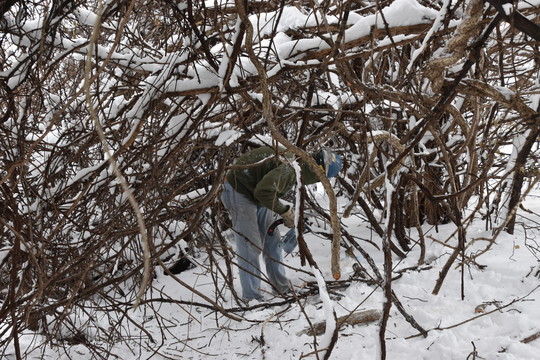|
November 5, 2019
November Weed of the Month: Weeds that Impact Hunters
Shane Blair, Minnesota Department of Agriculture
When hunting, weeds are often an afterthought or not thought of at all. Unfortunately, weeds can have a negative impact on wild game if ignored and not managed in a timely manner. Weedy species can also be burdensome to hunters.
Some noxious weeds that pose problems for hunters and wild game are Japanese barberry, Oriental bittersweet, buckthorn, and multiflora rose. These four noxious weeds pose different threats but have some similar characteristics:
- They take over the understory of wooded areas halting native regeneration.
- The weeds can affect wetlands or riparian areas.
- They harbor pests that can be harmful to humans and wild game.
- These weeds outcompete our native plants which wild game may seek out.
 Oriental bittersweet vines can become so dense that you have to crouch to travel through them.
Japanese barberry (Some Cultivars are Restricted Noxious Weed) was planted as an ornamental woody shrub. Barberry escaped cultivation and can be found naturalizing in the understory of some wooded areas in Minnesota. Once established, it can form impenetrable thickets. Deer do not browse on Japanese barberry because it is not favorable. Turkeys can eat the berries but cannot travel through the dense patches. Japanese barberry can provide the ideal environment for ticks.
Oriental bittersweet (Prohibited Eradicate Noxious Weed) is a woody vine that was sold as an ornamental. It is found in southeast Minnesota. Oriental bittersweet wraps around trees and other supports, resulting in girdled and smothered trees and shrubs. This vine can wipe out a forested area and leaves nothing behind but a huge mass of vines that are impenetrable and create deadfalls. Native species cannot regenerate under oriental bittersweet and some species of wild game cannot travel through it.
Glossy buckthorn and Common/European buckthorn (Restricted Noxious Weed) are both found in Minnesota. They were brought in as an ornamental shrub or small tree used for living fence rows and wildlife habitat. Both pose a serious threat to the degradation of native forest understory habitats. Buckthorn created thick infestations that prevent natural regeneration of forest tree and shrub species and can be impenetrable. Deer, turkeys, and squirrels are often drawn to row-crops, but buckthorn can serve as a host for alfalfa mosaic virus, oat crown rust, and soybean aphids which can affect the outcome of the crop/food source.
Multiflora Rose (Restricted Noxious Weed) is a highly invasive perennial shrub that was sold as a rootstock for ornamental roses. This plant was used for erosion control, living fence rows, and wildlife habitat. It can be found in forest understories, hedgerows, savannas, stream banks, wetlands, pastures, urban woodlots, roadsides, and other disturbed habitats. This plant is loaded with thorns making it hard for hunters and wild game to travel through. Multiflora rose also outcompetes our native vegetation, not allowing them to grow.
If vegetation becomes too dense, deer, turkey, grouse, and others can have a hard time navigating through them. Trees such as oaks, hickories, walnuts, and other native seedlings are shaded-out and over time eliminated from the forest floor. In turn, this reduces the amount of food and habitat quality produced, such as acorns or walnuts, that wildlife prefer. Deer, as do most animals, like to eat native plants rather than invasive exotic plants that tend to be unpalatable. If deer and other wild game have a hard time finding these native plants, they will eventually move and find new areas to occupy.
What once used to be a pleasurable experience for hunters and other wildlife advocates searching for wild game is now difficult to traverse due to thorns, impenetrable vines, or thickets. Areas once full of wild game have now become diminished. Over time, small patches of unmanaged weeds will spread and eventually dominate an entire forested, prairie, or wetland. The hunter can choose to do a quick fix and improperly trim out weedy areas, but this will only result in negative consequences for both hunter and wild game in future years. The best course of action would be for hunters to map or flag problem areas when out and develop active management plans in the off-season to eliminate future weed problems.
If the noxious weeds go unaddressed for too long, it can require significant time and money to correct and maintain ideal habitat diversity for deer and all other wildlife species. Take steps now to manage any noxious weeds present on your property.
There are many other invasive plants that can affect deer and other wild game, but these four are most commonly found in Minnesota. Further information on these noxious weeds and many others can be found on the Minnesota Department of Agriculture’s website. There you can find the background, a description, photos of various parts of the plants, habitat, means of spread and distribution, impact, prevention and management, as well as other links to help you learn about and manage any noxious weeds present on your property.
PHOTO
Caption: Oriental bittersweet vines can become so dense that you have to crouch to travel through them. Photo credit: Minnesota Department of Agriculture (Click here to download.)
MEDIA: For more information on Weed of the Month, contact Allen Sommerfeld, MDA Communications, at allen.sommerfeld@state.mn.us or 651-201-6185
Having trouble viewing this email? View it as a Web page.
|